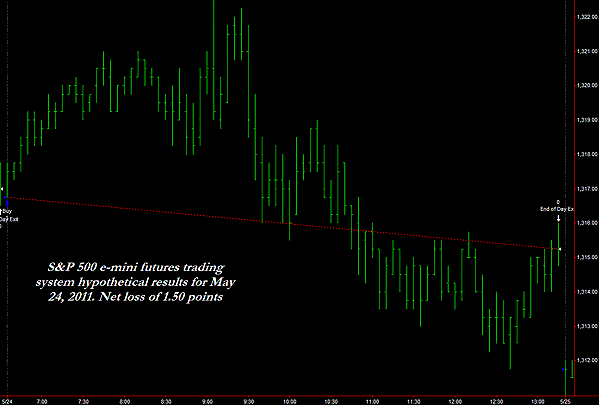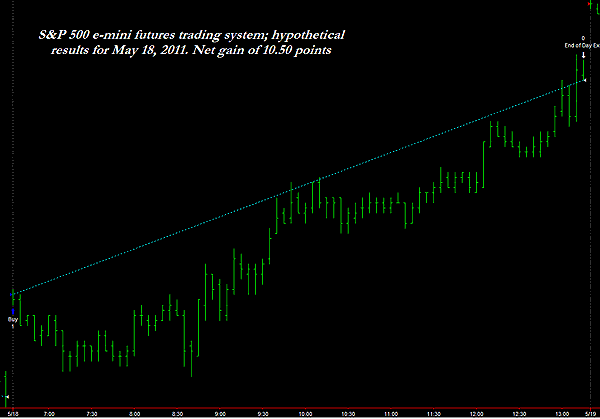
HOT TOPICS LIST
- MACD
- Fibonacci
- RSI
- Gann
- ADXR
- Stochastics
- Volume
- Triangles
- Futures
- Cycles
- Volatility
- ZIGZAG
- MESA
- Retracement
- Aroon
INDICATORS LIST
LIST OF TOPICS
PRINT THIS ARTICLE
by Donald W. Pendergast, Jr.
When selecting a trading system or method, be sure you can actually learn to live with its advantages and disadvantages.
Position: N/A
Donald W. Pendergast, Jr.
Donald W. Pendergast is a financial markets consultant who offers specialized services to stock brokers and high net worth individuals who seek a better bottom line for their portfolios.
PRINT THIS ARTICLE
TRADING SYSTEMS
Waiting For The Harvest
05/31/11 10:29:28 AMby Donald W. Pendergast, Jr.
When selecting a trading system or method, be sure you can actually learn to live with its advantages and disadvantages.
Position: N/A
| The emini stock index futures trading system under examination here is pretty basic: 1. It always goes to cash at the end of the daily trading session. 2. It utilizes a stop & reverse system logic. 3. It stays with the trade until the stop-loss is hit, a new reverse signal is given, or the end of the trading session arrives. Pretty simple, and in fact, the method gives solid backtested results and forward-testing results, too. A wise trader, however, would be well advised to actually take some time and look at the daily charts for all the trades to see just how his/her emotions will be tested, tried, frayed, and finagled with by the day-in, day-out series of losses and wins that will inevitably occur. |

|
| FIGURE 1: NO PAIN, NO GAIN. To be a successful system trader, you not only need a proven system, but you also need to let the system do all the work -- without human intervention. |
| Graphic provided by: TradeStation. |
| |
| For example, let's look at the hypothetical trade that took place on May 24, 2011; it was the only trade that day, going long at 1316.75 very early in the session. A couple of hours later, the open trade was up by nearly six points (that's almost $300 in the ES), but then the market sold off steadily, ultimately stopping the trade out at the end of its trading window at 1315.25 -- for a loss of 1.50 points or $75 before commissions and slippage. So what? For a disciplined system trader, such an occurrence is just a part of the daily grind of the trading business -- nothing more than a minor setback on the road to greater, and hopefully steadily accumulating gains in the future. See Figures 1 and 2. However, for fussbudgets, the impatient, and know-it-all types of traders out there, taking such a loss would have been all but insufferable. No, these immature traders probably would have found a way to cash in on the trade when it was up by two or even three points, taking seemingly safe and secure profits before learning of the final outcome of the market's intentions that day. In so doing, they wrest back the control from their well-tested, well-reasoned trading system instead of learning to trust it to produce profits on its own over a sustained period of time. If we look at another hypothetical trade, one that occurred on May 18, 2011, we see that a trader using the same brand of know-it-all mindset after going long at $1328.50 would probably have been in a state of near-panic once the trade had risen to the $1334 area (a $275 gain before commissions and slippage) and, if they had closed the trade then for a safe and secure profit, they would have missed out on the additional five points (a final closeout of $1339). Of that, the market would have gladly, freely, and easily given them -- if they'd simply had the patience and faith to stick with the system. |

|
| FIGURE 2: S&P 500 EMINI SYSTEM. While it would have been tempting to cut this trade short after it was up by five or even six points, wise traders know that it's almost always best to let the system make all of the trading decisions. Patient traders would have been well-served by following that policy in this hypothetical trade outcome. |
| Graphic provided by: TradeStation. |
| |
| So which camp are you in? Are you in the faithful and true camp, able to stay with a well-tested, battle-hardened system, or are you residing in the unstable and dangerous camp, terrified that the market may take away your little three-point winner? |
| Let's face it, some traders aren't cut out to hold a trade for four to six hours, much less four to six days, weeks, or months. They may be better served by going for one- and two-point moves with a very tight two-point stop-loss -- there are systems out there that can and do operate with that kind of logic. The main idea here is to make sure that you fully understand the nature of the system you're going to be trading, and that you have the mental, emotional, spiritual, and financial wherewithal to make a meaningful commitment to it for the long haul. Make sure you fully understand all of the myriad ways that your next trading system will test. |
Donald W. Pendergast is a financial markets consultant who offers specialized services to stock brokers and high net worth individuals who seek a better bottom line for their portfolios.
| Title: | Writer, market consultant |
| Company: | Linear Trading Systems LLC |
| Jacksonville, FL 32217 | |
| Phone # for sales: | 904-239-9564 |
| E-mail address: | lineartradingsys@gmail.com |
Traders' Resource Links | |
| Linear Trading Systems LLC has not added any product or service information to TRADERS' RESOURCE. | |
Click here for more information about our publications!
PRINT THIS ARTICLE

|

Request Information From Our Sponsors
- StockCharts.com, Inc.
- Candle Patterns
- Candlestick Charting Explained
- Intermarket Technical Analysis
- John Murphy on Chart Analysis
- John Murphy's Chart Pattern Recognition
- John Murphy's Market Message
- MurphyExplainsMarketAnalysis-Intermarket Analysis
- MurphyExplainsMarketAnalysis-Visual Analysis
- StockCharts.com
- Technical Analysis of the Financial Markets
- The Visual Investor
- VectorVest, Inc.
- Executive Premier Workshop
- One-Day Options Course
- OptionsPro
- Retirement Income Workshop
- Sure-Fire Trading Systems (VectorVest, Inc.)
- Trading as a Business Workshop
- VectorVest 7 EOD
- VectorVest 7 RealTime/IntraDay
- VectorVest AutoTester
- VectorVest Educational Services
- VectorVest OnLine
- VectorVest Options Analyzer
- VectorVest ProGraphics v6.0
- VectorVest ProTrader 7
- VectorVest RealTime Derby Tool
- VectorVest Simulator
- VectorVest Variator
- VectorVest Watchdog
